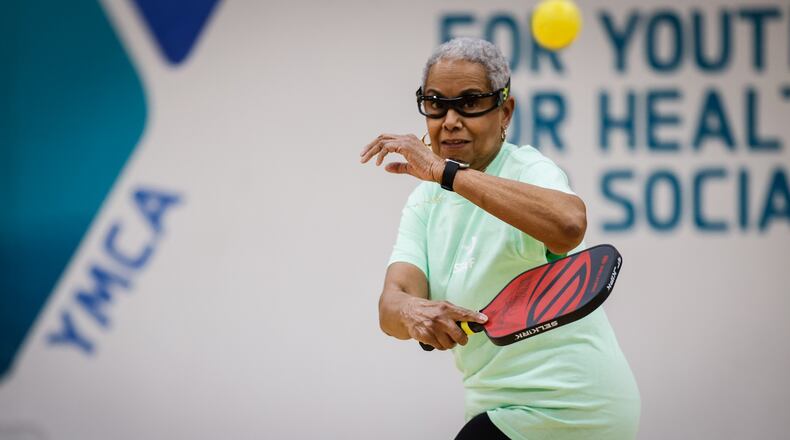The 73-year-old Clayton woman dropped a few extra pounds when she started and has maintained her weight. She takes low doses of medicine for slightly high blood pressure and cholesterol, but she is pleased with her numbers. Her doctor attributes her good health to not only the medication, but also her exercise.
“I’m sure if I were not exercising, I would not be this agile,” said the retired dental hygienist, who is a board member at the Kleptz branch and helps teach an introductory pickleball class there.
While older adults may face additional challenges to exercising and staying active, it is important to keep it up even after retirement.
Exercise also can reduce anxiety and improve sleep, and there is evidence that long-term it can reduce the risk of dementia, Parkinson’s disease and more, said Amanda Nichols, a nurse practitioner at Kettering Health Years Ahead Health Center.
“There’s a lot of evidence that exercise is medicine,” she said.
While some older adults may enjoy golf, virtual classes or going to the gym, walking is often the most accessible option, Nichols said. Walking can have the same benefits as running, and it doesn’t have to be vigorous.
Nichols starts by asking patients about their current exercise regimen. Even 2 or 3 minutes of continuous movement at a time helps, and starting slowly can keep it from becoming too intimidating. Park the car further away, or walk while talking to a friend.
“Any type of movement – it all adds up. The more, the better,” she said.
Adults with specific health conditions may have a mindset that they can’t be physically active, but there is often adaptive equipment, she said.
Active adults don’t need to work up a heavy sweat to improve their health. They should still be able to carry on a conversation during the activity, Nichols said. If the activity is enjoyable, the participant is more likely to continue doing it.
“You want it to become a habit,” said Nichols, who added that writing it down can help keep them accountable.
At the YMCA’s Kleptz branch in Englewood, water classes, pickleball and cornhole are among the most popular classes, said Amy Waltersheide, the branch’s senior membership director. The branch offers about 15 to 20 different activities specifically for older adults each week.
Credit: JIM NOELKER
Credit: JIM NOELKER
Waltersheide can help visitors choose an activity based on their needs and preferences, such as beach ball volleyball, chair yoga, an arthritis class or an activity in the warm-water therapy pool. An athletic trainer also is available.
“To be active, they need to be comfortable,” she said.
Members who prefer to work out alone also have options, and she said that many older adults are familiar with some of the equipment from previous rehabilitation efforts.
The most difficult part is first stepping through the door, Waltersheide said. Once they arrive, they can try as many activities as they like, finding the class or group that fits them best.
“You have to come in with an open mind,” she said.
White said that she wasn’t very active before she started at the YMCA with Zumba even before she retired. She doesn’t much enjoy exercise that has her moving from machine to machine, but she was drawn to Zumba’s music – another reason she likes line dancing, too.
When teaching beginners how to play pickleball, she tells them what to expect and acknowledges that it might not be a good fit for players with certain limitations. Age isn’t one of them. She also plays pickleball with a woman in her 80s.
But there is no one-size-fits-all exercise that is best for everyone, and there can be different levels of the same exercise that work better for different people – for example, a Zumba class that is not as high-impact, she said.
Some want to exercise alone, while others want to work out with a buddy. White enjoys the social aspect and meets her physical health goals while seeing improvements to her mental health, too.
“The hardest thing is to get people to know there’s something out there that’s for them to help them maintain their optimum health,” White said. “Don’t wait until it’s too late and you can’t do anything.”
About the Author



